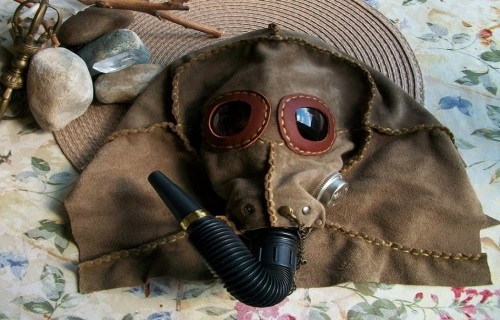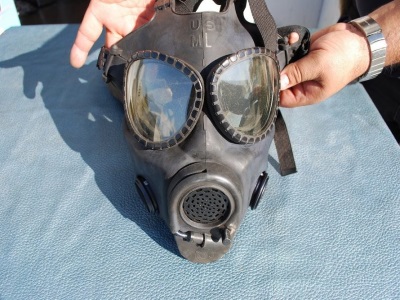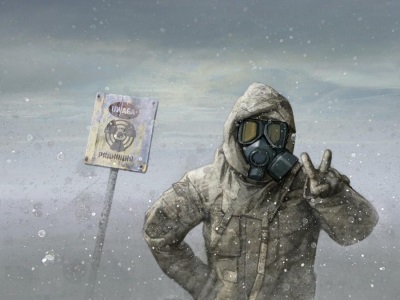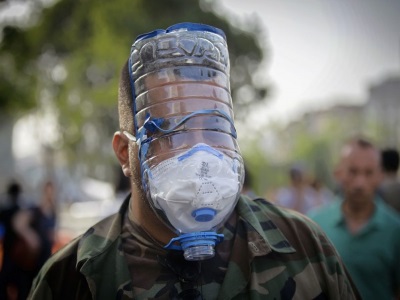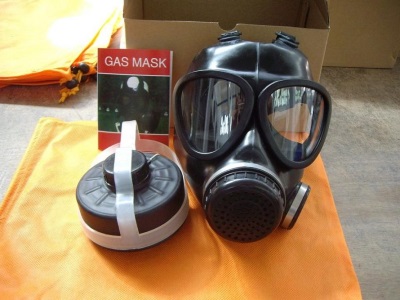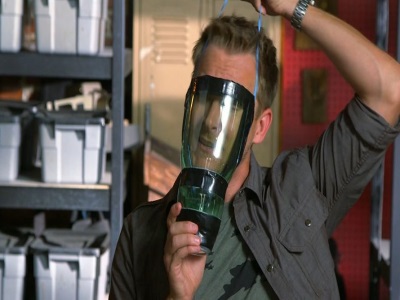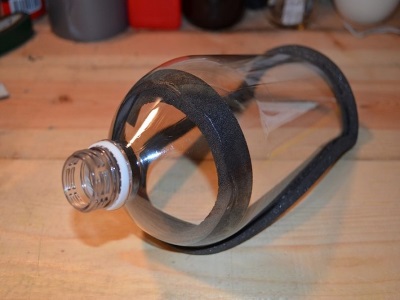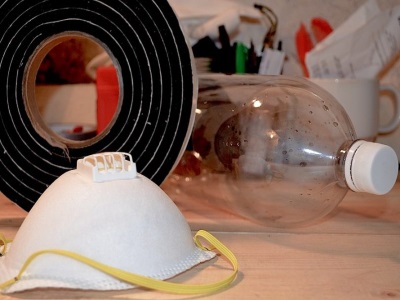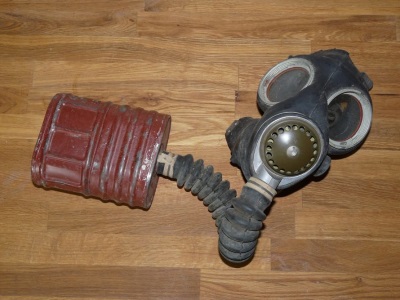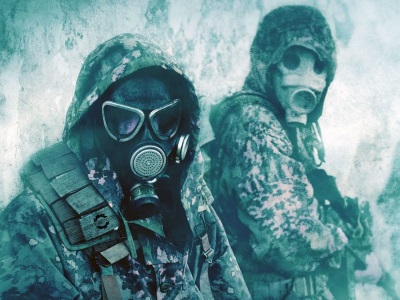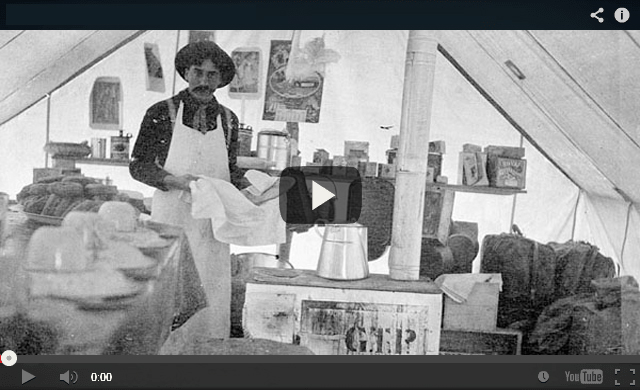The world we live in nowadays is one where everything can happen, and that means that planning for various survival situations is imperative. Being prepared even in the most dangerous situations is equivalent to knowing how to make all sorts of homemade, DIY items which can potentially save your life in case of a disaster.
One of the skills you have to master is how to make a gas mask quickly, because there are a number of perilous events that occur frequently – like a fire or a terrorist attack – when owning a gas mask can make the difference between life and death.
PRINCIPLES OF BUILDING A SOUND GAS MASK
As such, a gas mask is something that filters out the toxins in the air by employing the principle of adsorption and the principle of safety. The store bought items have these features, and some of the most proficient ones are better when it comes to adsorption and safety, because they can filter more foreign substances and be more effective even in increasingly toxic environments.
On the other hand, DIY gas masks are just improvised items, and given the fact that you don’t have topnotch materials or last generation tools at your disposal to make sure that everything is air-tight and functioning without fault, you may encounter issues when it comes to both adsorption and safety.
That being said, a quick analysis of these two key principles will help you understand how to craft a better homemade gas mask.
ADSORPTION
There is an important difference between absorption and adsorption. The first term refers to the process of encapsulating a substance, while adsorption refers to depositing a certain substance on a surface. In other words, you don’t want your gas mask to be absorbent, but adsorbent, which means it being capable of filtering out all sorts of dangerous particles and gases which might otherwise get stuck in your nose or lungs, and damage your respiratory system, rendering you unconscious.
Adsorption can be increased with the proper chemical reactions, keeping in mind that some substances interact and repel or attract each other. As such, if the air particles you want to counteract have a positive charge, you should use a substrate with a negative charge for your gas mask, like activated carbon or zeolites. The efficiency of this principle has already been confirmed even in the most usual situations: in case of fire, it is well know that covering your mouth and nose with a moist cloth is a good idea.
Conversely, this principle works only when it comes to particles that are a direct result of combustion, like fire or an explosion, but it doesn’t work as well when it comes to toxic gases or airborne pathogens.
SAFETY
Absorption also has an important role in the construction of a gas mask, because the filter doesn’t only have to separate the dangerous substances from the air, but it has to retain them. So if the filter isn’t very absorbent, the durability and resistance of your gas mask may be compromised.
As such, if the filter can’t take in anymore particles or dangerous chemicals, it won’t protect you anymore, which means it will be the same thing as having no mask at all. That’s why it’s wise to have some sort of sealing cap put over the air filter in order to prevent damage. But age, moisture and heat are also factors to take into account when it comes to the safety of your gas mask, since they change the chemical composition of the filter.
For example, you may build a gas mask today and not need to use it for a few years. But even if you haven’t used it at all until then, it may still become damaged because of the above listed factors. So it’s better to check the functionality of your gas mask, as not to risk it becoming totally useless. Even the older military gas masks degrade over time, so don’t count on the efficiency of a very old item, which maybe hasn’t been kept in the best conditions, because it can put your life in jeopardy instead of saving you.
Besides, it’s always best to keep up to date with news regarding dangerous substances, since scientific discoveries are constantly being done, and a substance that was considered safe a few decades ago might be proven dangerous today. It’s the case of blue asbestos which was introduced in the filters of gas masks used in World War II, about which we now know it’s dangerous and can lead to lung cancer. Moreover chromium is another substance that can lead to cancer.
So even if you don’t make your own gas mask and buy one from the store, or buy just a filter to replace the old one, it’s best to check if it doesn’t contain asbestos or other hazardous substance. However, even if that may not be the case, some gas masks for instance may use rubber in their construction, which although it isn’t dangerous in itself, will become damaged during time. That can lead to the appearance of cracks and leaks, making your gas masks totally unusable.
There is one more thing that can mess with the safety of your gas mask, especially if it’s a standard one: your facial hair. That’s because it makes it less air tight, no matter how long or short your facial hair is.
WHEN DO YOU NEED A GAS MASK?
Bad things happen to good people all the time and today’s world is not free of different natural or man-made disasters, when hazardous substances are produced or used, such as:
- A fire. Dust and ash can easily get stuck in your nose and lungs, causing you to faint before getting to safety.
- An earthquake. Fires are more likely to happen during an earthquake, but you may also find yourself immobilized with a lot of dust around you from the collapsing of your office building or home. Having a gas mask handy may save your life.
- Terrorist bombings. In Iraq 2007, a group of terrorist bombers used chlorine gas in their attacks, which managed to wound a few hundred people. Who says that can’t happen to us? Even if some gases are not necessary lethal, they can make you pretty sick. Otherwise, it’s better to be safe than sorry and be prepared.
- Riots. CS gas and tear gas are often used to deter rioters from continuing their actions, and if you get stuck in the middle and unfortunately have asthma or other lung affections, these gases can become lethal for you.
All these circumstances require something to keep your respiratory system protected in various emergency situations when air contamination occurs because of:
- Smoke
- Particulates
- Infectious agents.
- Airborne diseases.
- Chemicals
But you can use a gas mask even in more pacific conditions, like when you need to paint your garage door.
BUYING A GAS MASK OR MAKING ONE ON YOUR OWN?
It’s no secret that anyone can buy even military-grade gas masks from various stores, whether online or not, but they do have some disadvantages, such as high retail price and the need for regular maintenance.
The upside is that they offer the guarantee of quality and safety. Nevertheless, even if you buy the best gas mask there is, you can’t carry it around with you everywhere you go, because that would raise suspicion from other people, not to mention that it would prove rather uncomfortable – you can’t just put it in your briefcase since it wouldn’t fit.
The alternative to buying a gas mask is making one on your own, using materials you probably already have lying around your house, and which are pretty affordable in case you don’t. On the flipside, a DIY gas mask can protect you to some extent against fire or dust particles, but it’s not that effective as a standard or a military gas mask when it comes to biological or chemical attacks.
The filters, fibers, vents and valves used by topnotch military gas masks can filter out even the most dangerous chemicals from the air, but a homemade one is just a last resort which will never have the same quality.
However, a homemade gas mask can be a fun project and it can help you in some circumstances when you need protection.
THE BEST WAYS TO MAKE A GAS MASK
THE SODA BOTTLE GAS MASK
This is a nice DIY project, which offers you some benefits:
- Protection from a plethora of hazardous substances.
- Easy and fast to make – less than 15 minutes.
- You don’t need a lot of materials.
- You don’t need a lot of expertise.
- It’s cheap – under $5.
The items you need are:
- Sharp cutting tool.
- Permanent marker.
- Glue
- A half a gallon soda bottle.
- Rubberized foam insulation strip – minimum 1 inch wide.
- A N95 particulate mask.
The steps you need to take are:
- Clean the plastic bottle and remove the labels.
- Using the marker, draw an area shaped as an U which should be big enough to fit your face. It shouldn’t be bigger than that, in order for the mask to be air-tight, but it shouldn’t be uncomfortable either.
- Cut around the U shape with a razor or an exacto knife, and also remove the bottom. Adjust the shape until it fits perfectly.
- Put the rubberized foam insulation on the bottle’s edges, to create a seal.
- Make a circle of foam insulation inside the bottle, where you will place the N95 mask which acts as a filter.
- Place the N95 mask 2 inches up from the spout.
- Cut the N95 mask’s edging carefully, leaving enough to seal the edges.
- Place the N95 inside the neck of the bottle, pointing the filter out and down towards the spout.
- Use the elastic bands from the N95 mask to secure the gas mask to your face.
For safe keeping and best maintenance, put the finished gas mask in a plastic bag that’s well sealed or in an air-tight container.
To ensure that its filter doesn’t become contaminated, and you can confidingly use it in emergency situations.
MAKING THE AIR FILTER FOR YOUR GAS MASK
In order to further protect you from hazardous gases, you can make a homemade air filtration system to accompany the soda bottle gas mask.
It will certainly not be as high-quality or as efficient as a military-grade one, but it will filter better some toxins and particles in the air, offering you better protection from tear gas for instance.
The items you need are:
- 2 bottles of a quarter gallon each.
- Razor blade.
- Activated charcoal.
- Pillow stuffing. If you don’t have pillow stuffing, use rags from old shirts, socks or cotton balls.
- Duct tape.
- Rubber hose or old vacuum hose.
- Soap and water.
The steps you need to take are:
- Cut off the top of the bottle, using the razor blade to leave an open cylinder.
- Fill the bottom of the bottle with 3-4 inches of activated charcoal. This will absorb the noxious gases, filtering the air efficiently of chlorine and carbon-based chemicals.
- Cut the bottom of the other bottle, by slicing 1-2 inches with the razor blade. Remember to leave the cap on.
- Put 3-4 inches of pillow stuffing inside the top of this bottle. The pillow stuffing works well to remove physical contaminants such as dust, ash and tear gas from the air.
- Slide the bottles together and use tape to bind them shut. You will create a seal and finish the air filter.
- With the razor blade, make a few holes in your filter, at the end where the charcoal is, in order to allow air to get in. Don’t do this until you actually need to use the filter, or otherwise the activated charcoal will only absorb the moisture from the air, rendering it totally inefficient when you actually need it most.
- Clean a rubber hose or an old vacuum hose with soap and water.
- Use the rubber hose in order to connect the bottom of your air mask to the filter. Use duct tape to seal the ends shut.
- Remove the cap from your filter only when you need to use it. Otherwise, the charcoal will absorb the moisture from the air and the filter will become useless.
- Replace the activated charcoal every time you use the filter. Each use means that the activated charcoal will absorb chemicals and become full and therefore inefficient.
THE 1942 GAS MASK
Apparently chemical warfare was a big deal in 1942, and people learnt how to protect themselves from that by making their own gas masks, for which they needed:
- Canister or ordinary tin can.
- Bathing cap. This is the mask that comes on your face.
- Elastic
- Handkerchiefs
- Fly swatters.
- Charcoal and soda lime. This is wrapped in two layers of handkerchiefs and packed into the can.
- Powder-puff box. This has a clear lid, and it’s the window the user looks through.
- Adhesive tape.
- Snorkel
- Knife
- Wire
- Plastic cling-wrap.
The steps you need to take are:
- Using a knife, make an X shape at the top of your soda can.
- Fit the snorkel through the hole, but don’t push it all the way through.
- Drill a hole through the can flaps and the end of the snorkel tube.
- Insert a wire through the holes and bend the ends of this wire over to secure the assembly.
- Wrap the end of the can and the joint with the tube with plastic cling-wrap and tape.
- Crush the charcoal, mix it with water or soda lime until it turns into a paste, then dry it.
- Put a handkerchief in the base of the can, and another on top of that to prevent charcoal dust from going into the tube and your lungs.
- Put the charcoal in the can.
- Tape a handkerchief over the end of the can and cut off the excess.
As a conclusion, if you don’t have enough time to make a better gas mask because a fire has just started or you’ve been trapped under the debris caused by an earthquake, you can improvise a very rudimentary gas mask from a T-shirt. This can potentially save your life, as it manages to block some of the dust or ashes in the air.
To do this, all you need is a T-shirt or other cotton clothing item, which you tear in order to cover your nose and mouth with the strips. If you can get it moist before actually covering your respiratory ways with it, it will be even more efficient.
If, on the other hand, someone has been firing tear gas, use cider vinegar instead of water, because it will protect you from inhaling it. It won’t protect you for long, if you’re stuck somewhere, but if you’re moving to safety and can escape the dangerous area, it can do the trick.
IN CONCLUSION
Even though you are not in any immediate danger, knowing how to protect yourself in the case of a gas leakage is definitely a very useful information.
Hoping we managed to help you with the necessary information, we’re waiting for your opinion in comments.
Our grandfathers had more knowledge than any of us today and thrived even when modern conveniences were not available. They were able to produce and store their food for long periods of time. The Lost Ways is the most comprehensive book available. All the knowledge our grandfathers had, in one place.Here’s just a glimpse of what you’ll find in the book:
Table Of Contents:
Making Your Own Beverages: Beer to Stronger Stuff
Ginger Beer: Making Soda the Old Fashioned Way
How North American Indians and Early Pioneers Made Pemmican
Wild West Guns for SHTF and a Guide to Rolling Your Own Ammo
How Our Forefathers Built Their Sawmills, Grain Mills,and Stamping Mills
How Our Ancestors Made Herbal Poultice to Heal Their Wounds
What Our Ancestors Were Foraging For? or How to Wildcraft Your Table
How North California Native Americans Built Their Semi-subterranean Roundhouses
Our Ancestors’Guide to Root Cellars
Good Old Fashioned Cooking on an Open Flame
Learning from Our Ancestors How to Preserve Water
Learning from Our Ancestors How to Take Care of Our Hygiene When There Isn’t Anything to Buy
How and Why I Prefer to Make Soap with Modern Ingredients
Temporarily Installing a Wood-Burning Stove during Emergencies
Making Traditional and Survival Bark Bread…….
Trapping in Winter for Beaver and Muskrat Just like Our Forefathers Did
How to Make a Smokehouse and Smoke Fish
Survival Lessons From The Donner Party
Get your paperback copy HERE
Here’s just a glimpse of what you’ll find in The Lost Ways:
From Ruff Simons, an old west history expert and former deputy, you’ll learn the techniques and methods used by the wise sheriffs from the frontiers to defend an entire village despite being outnumbered and outgunned by gangs of robbers and bandits, and how you can use their wisdom to defend your home against looters when you’ll be surrounded.
Native American ERIK BAINBRIDGE – who took part in the reconstruction of the native village of Kule Loklo in California, will show you how Native Americans build the subterranean roundhouse, an underground house that today will serve you as a storm shelter, a perfectly camouflaged hideout, or a bunker. It can easily shelter three to four families, so how will you feel if, when all hell breaks loose, you’ll be able to call all your loved ones and offer them guidance and shelter? Besides that, the subterranean roundhouse makes an awesome root cellar where you can keep all your food and water reserves year-round.
From Shannon Azares you’ll learn how sailors from the XVII century preserved water in their ships for months on end, even years and how you can use this method to preserve clean water for your family cost-free.
Mike Searson – who is a Firearm and Old West history expert – will show you what to do when there is no more ammo to be had, how people who wandered the West managed to hunt eight deer with six bullets, and why their supply of ammo never ran out. Remember the panic buying in the first half of 2013? That was nothing compared to what’s going to precede the collapse.
From Susan Morrow, an ex-science teacher and chemist, you’ll master “The Art of Poultice.” She says, “If you really explore the ingredients from which our forefathers made poultices, you’ll be totally surprised by the similarities with modern medicines.” Well…how would you feel in a crisis to be the only one from the group knowledgeable about this lost skill? When there are no more antibiotics, people will turn to you to save their ill children’s lives.
If you liked our video tutorial on how to make Pemmican, then you’ll love this: I will show you how to make another superfood that our troops were using in the Independence war, and even George Washington ate on several occasions. This food never goes bad. And I’m not talking about honey or vinegar. I’m talking about real food! The awesome part is that you can make this food in just 10 minutes and I’m pretty sure that you already have the ingredients in your house right now.
Really, this is all just a peek.
The Lost Ways is a far–reaching book with chapters ranging from simple things like making tasty bark-bread-like people did when there was no food-to building a traditional backyard smokehouse… and many, many, many more!
Books can be your best pre-collapse investment.
The Lost Ways (Learn the long forgotten secrets that helped our forefathers survive famines,wars,economic crisis and anything else life threw at them)
Survival MD (Best Post Collapse First Aid Survival Guide Ever)
Conquering the coming collapse (Financial advice and preparedness )
Liberty Generator (Build and make your own energy source)
Backyard Liberty (Easy and cheap DIY Aquaponic system to grow your organic and living food bank)
Bullet Proof Home (A Prepper’s Guide in Safeguarding a Home )
Family Self Defense (Best Self Defense Strategies For You And Your Family)
Survive Any Crisis (Best Items To Hoard For A Long Term Crisis)
Survive The End Days (Biggest Cover Up Of Our President)
David Dawson is a retired security specialist with over 20 years of experience. He worked for a secret manufacturing facilities and hospitals in Illinois. David’s responsibility was to protect people in case of any disaster or cataclysm that might occur. Now he keeps on doing it through teaching others about how to prepare and survive flood, earthquake or even war.

